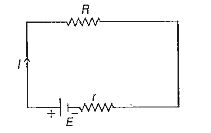What are the differences between terminal potential difference and emf of the cell. Deduce an expression for internal resistance of a cell.
Text Solution

Internal resistance of a cell is the resistance offered by the electrolyte of the cell to the flow of current. Hence, if we consider a cell of emf E and internal resistance r is connected across an external resistance R.

∴ Current drawn from the cell, I=ER+r ...(i)
where, E= emf of the cell, R= external resistance and r= internal resistance of a cell
Now from Ohm.s law,
V=IR⇒I=VR ...(ii)
From Eqs. (i) and (ii), we have VR=ER+r⇒r=(EV−1)R
It can also be expressed as, r=E−VI
|
Similar Questions
Knowledge Check
The terminal potential difference of a cell is greater than its emf when it is
Abeing dischargedBbeing chargedCin open circuitDshort circuitedFor a cell, a graph is plotted between the potential difference V across the terminals of the cell and the current I drawn the cell. The emf and the internal resistance of the cell are E and r, respectively. Then
 AE=2V,r=0.5ΩBE=2V,r=0.4ΩCE>2V,r=0.5ΩDE>2V,r=0.4Ω
AE=2V,r=0.5ΩBE=2V,r=0.4ΩCE>2V,r=0.5ΩDE>2V,r=0.4ΩA cell has emf of 2.2 V, when connected to a resistance of 5Ω, the potential difference between the terminals of the cell becomes 2.1 V, the internal resistance for the cell is
A0.12ΩB0.48ΩC0.24ΩD0.50Ω
Can the terminal potential difference of a cell exceed its e.m.f. ?
View SolutionDistinguish between emf and terminal potential difference of a cell.
View SolutionFor a cell, a graph is plotted between the potential difference V across the terminals of the cell and the current I drawn the cell. The emf and the internal resistance of the cell are E and r, respectively. Then

View SolutionA cell of emf E is connected across a resistance R. The potential difference between the terminals of the cell is found to be V. The internal resistance of the cell must be -
View Solutionv31
View Solution
